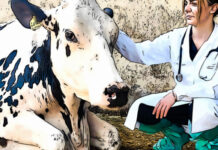Animal welfare is still awaiting an ‘EU strategy’ that will see the light of day several years from now, as it turns out. Animal health, the subject of a recent reform that we also described, moreover, already defines an essential requirement that is worth clarifying.
Only healthy animals may be slaughtered for human consumption, and this must be done in an approved slaughterhouse that is supervised by an official veterinarian in accordance with Reg. EC 853/04 (so-called Hygiene 2). Emergency slaughter outside the slaughterhouse – i.e., ʹThat carried out on an otherwise healthy animal that suffered an accident that prevented its transport to slaughter for welfare considerationsʹ – is instead allowed for only the domestic ungulates intended for human consumption and only when a number of conditions are met. (1)
Emergency slaughter
ʹFood business operators must ensure that meat from domestic ungulates, which have undergone emergency slaughter outside the slaughterhouse, is intended for human consumption only if it meets the following requirements.
1. An otherwise healthy animal must have suffered an accident that prevented its transport to slaughter for welfare considerations.
2. A veterinarian must perform ante-mortem inspection of the animal.
3. The slaughtered and bled animal shall be transported to the slaughterhouse under satisfactory hygienic conditions and without undue delay. Removal of the stomach and intestines, but no other grooming can be done on site under veterinary supervision. The viscera removed must accompany the slaughtered animal to the slaughterhouse and be identified as belonging to the animal.
4. If more than two hours elapse between the slaughter operation and arrival at the slaughterhouse, the animal must be refrigerated. If climatic conditions permit, active refrigeration is not necessary.
5. A statement from the food business operator who raised the animal, certifying the identity of the animal and indicating the veterinary products or other treatments administered to the animal with their dates of administration and withdrawal times, must accompany the slaughtered animal to the slaughterhouse.
6. A statement from the veterinarian, stating the positive result of the ante-mortem inspection, the date, time and reason for the emergency slaughter, and the nature of any treatment administered to the animal by the veterinarian, must accompany the slaughtered animal to the slaughterhouse.
7. The slaughtered animal shall be fit for human consumption after the post-mortem inspection carried out in the slaughterhouse in accordance with Regulation (EC) No. …/2004 [now EU reg. 2019/627] (…) including any additional tests in case of emergency slaughter.
8. Food business operators must follow any instructions from the official veterinarian after post-mortem inspection regarding the use of meat.ʹ (EC Reg. 853/04, All. III, Sec. I, Chapter VI).
The animal manager
The person responsible for animals-whether the owner, keeper and/or keeper of the animals-has a number of obligations, defined in Leg. 26.3.01, n. 146(Implementation of Directive 98/58/EC on the protection of animals kept for farming purposes).
ʹSick or injured animals should receive appropriate treatment immediately, and if an animal does not respond to such treatment, a veterinary doctor should be consulted. Where necessary, sick or injured animals are isolated in special rooms equipped, where appropriate, with dry or comfortable beddingʹ (Legislative Decree 146/01, Annex).
When the conditions for emergency slaughter are met, it is the responsibility of the person in charge of the animal to promptly contact the public veterinary service.
The veterinary public service
The public veterinary service is an essential public service that must ensure the inspection of dead or life-threatening animals, resulting in emergency slaughter. The service must also be provided during night and holiday hours under veterinary readiness. (2)
Emergency slaughter is prioritized over any other call. This is necessary for the protection of animal welfare, prevention of infectious diseases and food safety. (3)
Ante- and post-portem veterinary inspection is the responsibility of the public veterinary service.
Preventive stunning
Emergency slaughter must be carried out as quickly as possible in accordance with the provisions set forth in Reg. EC 1099/09, practicing preventive stunning of the animal.
The official veterinarian preliminarily ascertains the possession of the certificate of fitness by the personnel in charge (EC Reg. 1099/09, Article 7.2) and supervises the culling operations, which must spare the animal avoidable pain, anxiety or suffering.
Stunning must be performed by captive bolt gun or otherwise by one of the methods authorized by reg. EC 1099/09.
Fate of meat
Meat obtained from emergency slaughtered animals-where judged unconditionally fit for human consumption following ante- and post-mortem inspection-receives health stamps and is freely placed on the market. Unless found to be excluded from the scope of reg. EC 853/2004, when intended for private family consumption.
The official veterinarian at the slaughterhouse may in any case impose requirements on the use of fresh meat obtained from animals undergoing emergency slaughter outside the slaughterhouse, conditioning its subsequent treatment for human consumption (reg. EU 2019/627, Chapter IV – Restrictions, Article 47).
Carcasses, meat and viscera of emergency slaughtered animals declared fit for human consumption and yet not intended for commercial reasons may be qualified as an animal by-product(Category 3materials ).
If, on the other hand, meat obtained from emergency slaughtered animals is deemed unfit for human consumption as a result of ante- and post-mortem inspection, it is instead categorized as an animal by-product and disposed of in accordance with the provisions of Section 2(Disposal and Use) of Regulation (EC) No. 1069/2009.
Dario Dongo and Giulia Torre
Notes
(1)ʹDomestic animalsʹ means ʹmeatfrom domestic animals of the bovine (including Bubalus and Bison species), porcine, ovine and caprine species and domestic solipedsʹ (EC Reg. No. 853/2004, Annex I)
(2) Ministry of Health, Note DGISAN 4577 11.2.2020
(3) Idem c.s.
(4) Reg. EC 1069/09, Articles 8(Category 1 materials), 9(Category 2 materials), 10(Category 3 materials)









